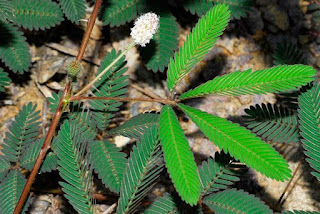Common name - Nidikumba
Botanical name - Mimosa pudica
Family - Fabaceae
Life cycle - Annual
Morphology
Diffuse undershrub, 50-90 cm high.
The stem and rachis are clothed with prickles
The leaves are bipinnate, pinnae 2-4, digitatively arranged, with 10-20 pairs of leaflets
The flowers in pinkish globose heads
The flowers are pollinated by the wind and insects.
The pods, small, flat, straw-coloured, with many bristles, the seeds, 3-5.
Propagation
In cultivation, this plant is most often grown as an indoor annual, but is also grown for ground cover.Propagation is generally by seed.
Agricultural usage/ importance
The species can be a troublesome weed in tropical crops, particularly when fields are hand cultivated. Crops it tends to affect are corn, coconuts, tomatoes, cotton, coffee, bananas, soybeans, papaya, and sugar cane. Dry thickets may become a fire hazard. In some cases it has become a forage plant although the variety in Hawaii is reported to be toxic to livestock.
Mimosa pudica can form root nodules that are habitable by nitrogen fixing bacteria.The bacteria are able to convert atmospheric nitrogen, which plants cannot use, into a form that plants can use.
Grown as an ornamental, its touch-sensitive leaves create interest among adults and children alike, helping to inspire interest in plant life generally. It has many traditional medicinal uses.
Control method
Herbicide: Dicamba, Triclopyr + picloram, FluroxypyrDo not disturb plants before spraying as leaves will fold up reducing surface exposed to the spray.


No comments:
Post a Comment